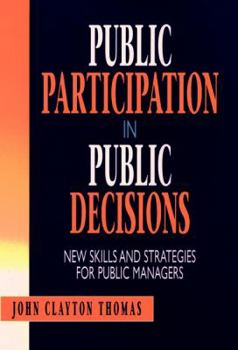Public Participation in Public Decisions: New Skills and Strategies for Public Managers
Select Format
Select Condition 
Book Overview
This straightforward and practical guide outlines a strategic approach to public involvement in government decision making. Prepares public managers for the difficult task of involving citizens more... This description may be from another edition of this product.
Format:Hardcover
Language:English
ISBN:0787901296
ISBN13:9780787901295
Release Date:August 1995
Publisher:Jossey-Bass
Length:240 Pages
Weight:0.95 lbs.
Dimensions:0.8" x 6.2" x 9.3"
Customer Reviews
2 ratings
Great classic themes - needs new edition
Published by Thriftbooks.com User , 16 years ago
Very interesting book - bought it to learn how to get the public my job serves more involved in decision making. Great classic themes on how to get the nebulous public groups to speak up and help out! The info is laid out logically and clearly. Fascinating case studies. Only problem - published 1995. Author alludes to the coming 'technological revolution' of electronic mail and fax. It would be wonderful to hear the author's current thoughts on how email and websites can be used to solicit public opinion.
Public Participation: A Contingency Framework
Published by Thriftbooks.com User , 21 years ago
Public participation in public decisions has been an enduring theme promoted by both public administration scholars and practitioners, behind of which has been a fix belief in its positive impact on the quality and responsiveness of public decisions, implementation efficiency and cost-effectiveness, and its potential to unchain the power of public ideas and to develop a strong sense of civic engagement-a subsistence for broader and intense practice of democracy. Beginning with the Great Society legislations of the 1960s that required maximum feasible participation of communities in development projects, the sensibility in favor of a broader public participation has turned to be a mandate. Unorthodox public administration currents, including New Public Administration of the 1970s and 1980s, and New Public Management of the 1990s, have consistently called for broader and engaged public participation in the hope that broader public involvement would bring about wide-ranging benefits, some of which have been mentioned in the preceding lines. Though fed by a religious-like persuasion, most of the early scholars in the trench of public participation neglected or failed in developing a contingency model of public participation that would help public managers to analyze the context of public participation so that a productive, engaged and distortion-free dialogue process accompanied by public participation could be planned and achieved. Deprived of a fully understanding of a productive public participation process, first public participation initiatives taken by public managers proved to be frustrating for both undertaking public agencies and aspiring community participants.The book I am reviewing is really such one that comes up with a contingency framework for public participation that thoroughly inquires into "when and how" questions of public participation, with having a number of productive, well-crafted, and context-dependent strategies and recommendations. Public Participation in Public Decisions is organized around ten major chapters. In the first three chapters of the book, Thomas (1995) gets readers to three points. First, the author criticizes the orthodox public administration theory due to its lack of enthusiasm for public participation; second, justifies the necessity for public participation with numerous reasons; and finally, points to the importance of finding a "practical" approach to public involvement for making it really work rather than keeping it as "rhetoric". From the fourth to the eight chapters, Thomas (1995) explains the important parameters in public participation process. The parameters point out the critical decision points as to when and how public administrators should involve citizens in public decisions. In the ninth chapter, Thomas (1995) pays attention to the new forms of public involvement including ombudspersons and action centers, co-production and volunteerism. The tenth chapter includes a summary view and conclud





